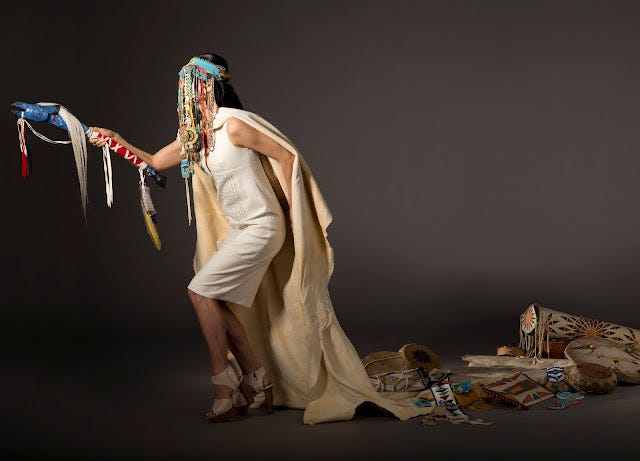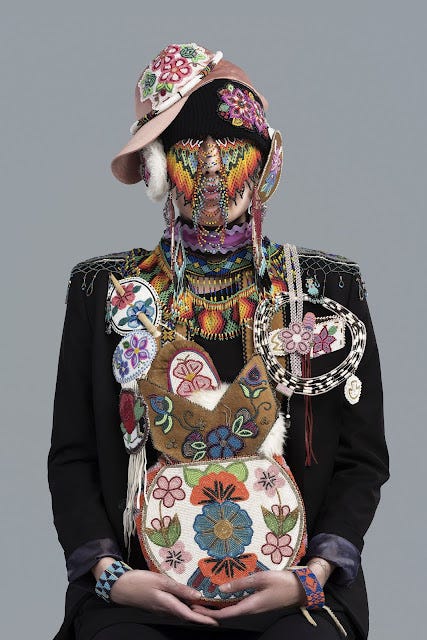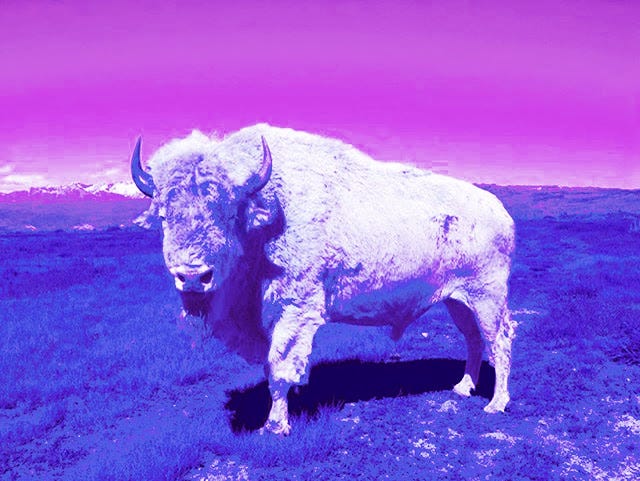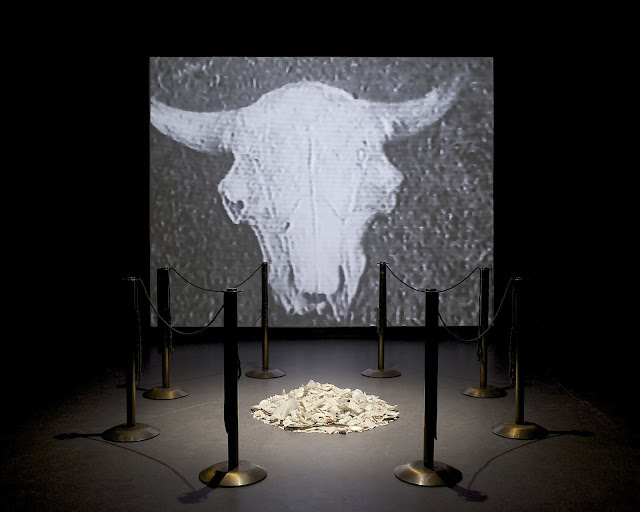Cultural Belongings by Dana Claxton, LED Firebox, 2016.
I'm influenced by my own experience as a Lakota woman, as a Canadian, a mixed blood Canadian, and then my own relationship to the natural and supernatural world. Taking that whole bundle of experiences, it all goes in to the artwork, I think that's where the multi-layering comes in, because I've had a very multi-layered life.
– Dana Claxton, 2007
As a person of mixed heritage, Dana Claxton is practically a living mirror of the paradoxical nation of Canada being superimposed over the existing nations that were already here in the first place, and especially of her own uniquely personal family history of indigenous displacement and migration. As such, perhaps her fascination with the hybrid nature of parallel realities comes to her almost as a genealogical birthright. This fact certainly helps to clarify our deep appreciation of her as someone existing at the heart of intersecting forces and the crux of competing cultures, and maybe it explains why she’s such an effective ambassador between such seemingly disparate dimensions.
So when she picked up her first camera at the age of sixteen and began to view the world around her, it now seems only natural that she should have tried to bring into focus the many layers that formed her own character. Born in Yorkton, Saskatchewan, and raised in Moose Jaw, Claxton is descended on her mother’s side from Kangi Tamaheca and Anpetu Wastewin, who were among the large group of Hunkpapa Lakota who followed Sitting Bull as he walked from the United States to Canada after the Battle of the Little Big Horn in 1876. Although the exiled Sitting Bull and many of his people returned to the U.S. in 1881, some 150 of them, including Claxton’s great-grandparents, remained encamped in the Moose Jaw River Valley. Eventually, they were granted land in the form of the small Wood Mountain Reserve in 1930 by an order in council of the Canadian Government, with Claxton’s great-grandfather serving as one of the signatories on the agreement.
From an early age, the future artist was taught how to harvest and preserve food by her paternal Euro-Canadian grandmother while also being taught to seek justice by her maternal Lakota grandmother. Eventually gravitating to the alternative music and underground art scenes in early 1980’s Vancouver, and after studying theatre and art, including on a three-year stint in New York, she returned to Vancouver and became involved in curatorial projects connected to the Pitt Gallery and began to explore both her own performance work and film/video as her primary medium. She was awarded a well-deserved Eiteljorg Fellowship for Native American Fine Art in 2007, in recognition of her achievements as a vital cultural catalyst.
Headdress-Jeneen, LED Firebox, 2018.
Aesthetic agent provocateur par excellence. That’s the most accurate artistic and spiritual job description I could ascribe to the interdisciplinary persona and complex work of Dana Claxton and the multi-layered life she shares with us in each new exhibition. She operates passionately in the interstitial zones, traveling the conceptual and emotional crossroads where traditions collide and cultures overlap. Her entire lengthy trajectory as a mixed-media artist has been a celebration of the challenges facing both individuals and societies when they try to express their essence. When worldviews collide, the sparks they give off form the raw material of both her formal style as an artist and her personal agenda as a social activist.
Whether we call it a survey show or a retrospective exhibition, the career overview of Claxton’s work at the Vancouver Art Gallery, Fringing the Cube, which was curated by Audain Curator of British Columbia Art Grant Arnold. It was an ideal opportunity to delve deep into the ethos of the Hunkpapa Lakota filmmaker, photographer and performance artist. Her compelling work focuses our attention on presumed stereotypes, mutually exclusive historical contexts and challenging gender studies in the lived experiences of indigenous peoples of the Americas, specifically those of the First Nations.
This richly evocative curated map traced the path of three decades of her art, and was also an instructive vehicle for reminding us all that the Vancouver Art Gallery is situated on the traditional, ancestral and unceded territories of the xʷməθkʷəy̓əm (Musqueam), the Sḵwx̱wú7mesh (Squamish) and səl̓ilwətaɁɬ (Tsleil-Waututh) peoples, and is respectful of the indigenous stewards of the land it occupies. The selection made by Arnold provided a valuable aerial view of the emotional and psychological landscapes containing her provocative pieces, at an altitude high enough to offer us an expansive and comprehensive view, the first-ever retrospective glimpse of her thoughtfully composed and beautifully crafted explorations of identity, gender and the nebulous nature of embodiment.
Tatanka (Buffalo), Chromogenic Print, 2013.
What makes Claxton’s works subversive and provocative is not necessarily the use of taboo imagery or disturbing content but rather the way she displaces the viewer’s expectations about indigenous art and culture by immersing us in a readily accessible pop-cultural domain. She also often utilizes beauty itself subversively, and seductively, to unearth difficult truths about colonialism and its lasting impact on both cultures involved. By combining, even mashing up, contemporary technologies and aesthetic strategies with traditional spiritual practices and native motifs, she disrupts the operative and often unconscious stereotypes in both the cultures she so ably critiques.
For her, performance is also a key aspect of ceremony, and any public staging of a theatrical act is simultaneous gift giving in the most traditional sense of shared generosity. She utilizes the sacred motif of the buffalo as a living spirit in several different formats throughout her works, among them Buffalo Woman 1 and 2 (2016), a photo-silk-screened image executed on two semi-transparent floating silk sheets in which she holds a sand-cast glass buffalo skull (fabricated by Kevin McKenzie) aloft in a gesture of both thanksgiving and lament.
Buffalo Bone China (1997) is a truly profound metaphysical experience. This installation, almost overwhelming in its simple grandeur, utilizes the jagged fragments of broken bone china placed on the floor in a sacred circle surrounded by stanchions and cords appearing to contain buffalo tails, behind which is archival black-and-white footage of stampeding bison. The darkened gallery became sanctified space in ways it is difficult to describe: she has transposed Lakota spiritual space into a contemporary museum in a manner which the heart feels long before the mind registers its evocative messages.
Fringing the Cube also included an indigenous inflection on the common conceptual format of the LED Lightbox. By calling hers "fireboxes," she effortlessly shifted their meaning into both an ancient and a modern context with multiple poetic allusions. Tantaka (Buffalo), an almost psychedelic chromogenic print from 2013, Paint Up 1 and Paint Up 2 (2009), Headdress (2015), Cultural Belongings (2016), and Headdress-Jeneen (2018) were among the most arresting examples of this uniquely indigenized hi-tech advertising methodology. I suggest you may want to order the VAG’s superb hardcover overview catalogue of this important artist’s oeuvre.
Buffalo Woman 1, Ink on Silk, 2016.
Just as psychology reconstructs the original traumatic situation in order to release the repressed material for individuals, we can also be plunged back into the archaeo-psychic past, collectively uncovering hidden histories that have been either dormant or concealed for epochs. Claxton’s often therapeutic art perfectly captures the process of disrobing the collective psyche. As her emblematic works demonstrate, the historic trauma of an entire culture can also be effectively excavated in an ongoing archaeology of memory. It is precisely this phenomenon, from a living representative of a biological kingdom letting her bloodstream testify to its survival and forward flow, that makes each new installation in her career arc another tree in the forest of her culture’s total memory.
Claxton once expressed her commitment very well in the curatorial essay for The Medicine Project: “We expect a great deal from art, and art gives us so much. To locate medicine through the application of art-making is an enormous undertaking. Artworks have the considerable potential to shift contemporary consciousness toward support of Aboriginal justice.” Curator Arnold emphasized another aspect of her fruitful career in his own catalogue essay: “It is important to note that the artworks represented in this exhibition and the catalogue that accompanies it are only one aspect of a broader project of reclaiming and redefining Indigenous culture she has taken on. Over the past thirty years she has scripted plays, produced and directed children’s programs and documentary films for broadcast television, organized conferences, participated in the Sundance at Standing Rock, curated exhibitions, taught in schools of journalism, edited anthologies and written extensively on Indigenous art. Claxton has employed a diverse set of strategies in her efforts to reclaim history and assert and Indigenous presence within it, intertwining the past and the present and creating new simulations to counter the ‘indian’ stereotype runs through much of Claxton’s work.”
Buffalo Bone China, Mixed media installation, single channel video, 2016.
When her visual motifs suddenly come to life via motion, as in her wide-ranging body of works in 16mm, single- and multi-channel projections and video pieces, the content of her artistic agenda shifts into high gear. Rattle, a four-channel work from 2003, is an excellent example of an equivalent shift in emphasis from the devastation of colonialism to the meditative absorption of Lakota spiritual practice. Described by the artist as “a visual prayer attempting to create infinity,” this work powerfully calls upon Lakota cosmology through a series of meaningful motifs that offer an inexplicable experience of healing to the visitor, whatever our cultural background might be.
I would suggest that rather than merely making space for the indigenous subject within the gallery/museum system, her works actually stake a valid indigenous claim to that space, a mind or spirit claim, perhaps, to a territory too often perceived as a colonial power base. In keeping with this last aim, and as an added enhancement of the exhibition proper, in her dialogic encounter with the permanent collection of the VAG, Claxton also collaborated intuitively with the curator of her survey show by selecting and including within the flow of her own works pieces by other artists that engage in a conversation with her images, films and objects. Thus multiple and simultaneous dialogues unfolded in a visual and haptic narrative designed to confront the visitor with an undeniable continuity which often takes place at the most subtle unconscious levels.
As Claxton clarified it so well: “Artworks can translate and mingle with each other in various ways, form, colour, context and praxis. Selections were made from the Permanent Collection of prints, photographs, paintings and sculptures and interwoven throughout this exhibition. Art collections speak and reveal themselves, as curatorial listening involves and openness to hear the soul of the artworks.” For over thirty years, her primary objective has been to bring a ritual and spiritual space into the mediating environment of our public galleries and museums. This core desire was achieved with enlightening results in the Vancouver Art Gallery’s extensive embrace of her ongoing efforts to embody cultural sovereignty while also personifying social reconciliation.
This article also appeared in the magazine Vie des Arts.
– Donald Brackett is a Vancouver-based popular culture journalist and curator who writes about music, art and films. He has been the Executive Director of both the Professional Art Dealers Association of Canada and The Ontario Association of Art Galleries. In addition to numerous essays, articles and radio broadcasts, he is also the author of two recent books: Yoko Ono: An Artful Life, and Double Solitaire: The Films of Charles Brackett and Billy Wilder.








A fine article about things that are close to my heart. Thanks Donald.